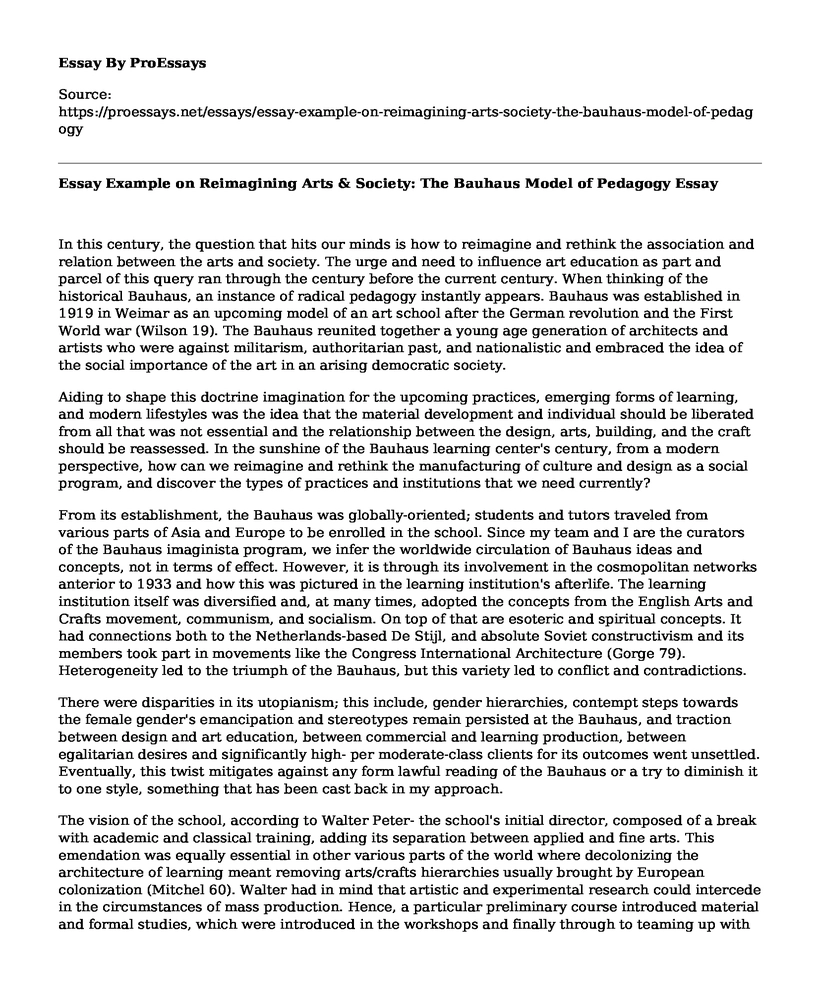In this century, the question that hits our minds is how to reimagine and rethink the association and relation between the arts and society. The urge and need to influence art education as part and parcel of this query ran through the century before the current century. When thinking of the historical Bauhaus, an instance of radical pedagogy instantly appears. Bauhaus was established in 1919 in Weimar as an upcoming model of an art school after the German revolution and the First World war (Wilson 19). The Bauhaus reunited together a young age generation of architects and artists who were against militarism, authoritarian past, and nationalistic and embraced the idea of the social importance of the art in an arising democratic society.
Aiding to shape this doctrine imagination for the upcoming practices, emerging forms of learning, and modern lifestyles was the idea that the material development and individual should be liberated from all that was not essential and the relationship between the design, arts, building, and the craft should be reassessed. In the sunshine of the Bauhaus learning center's century, from a modern perspective, how can we reimagine and rethink the manufacturing of culture and design as a social program, and discover the types of practices and institutions that we need currently?
From its establishment, the Bauhaus was globally-oriented; students and tutors traveled from various parts of Asia and Europe to be enrolled in the school. Since my team and I are the curators of the Bauhaus imaginista program, we infer the worldwide circulation of Bauhaus ideas and concepts, not in terms of effect. However, it is through its involvement in the cosmopolitan networks anterior to 1933 and how this was pictured in the learning institution's afterlife. The learning institution itself was diversified and, at many times, adopted the concepts from the English Arts and Crafts movement, communism, and socialism. On top of that are esoteric and spiritual concepts. It had connections both to the Netherlands-based De Stijl, and absolute Soviet constructivism and its members took part in movements like the Congress International Architecture (Gorge 79). Heterogeneity led to the triumph of the Bauhaus, but this variety led to conflict and contradictions.
There were disparities in its utopianism; this include, gender hierarchies, contempt steps towards the female gender's emancipation and stereotypes remain persisted at the Bauhaus, and traction between design and art education, between commercial and learning production, between egalitarian desires and significantly high- per moderate-class clients for its outcomes went unsettled. Eventually, this twist mitigates against any form lawful reading of the Bauhaus or a try to diminish it to one style, something that has been cast back in my approach.
The vision of the school, according to Walter Peter- the school's initial director, composed of a break with academic and classical training, adding its separation between applied and fine arts. This emendation was equally essential in other various parts of the world where decolonizing the architecture of learning meant removing arts/crafts hierarchies usually brought by European colonization (Mitchel 60). Walter had in mind that artistic and experimental research could intercede in the circumstances of mass production. Hence, a particular preliminary course introduced material and formal studies, which were introduced in the workshops and finally through to teaming up with the industry. After the first director, the school in all its different phases firmly remained a school meant for practitioners guided by practitioners grounded in material experimentation.
The Bauhaus dissolved autonomously in 1934, rather than being closed down by Nazis. As a result of that, as many worldwide students and tutors fled Germany, the ideas and concepts of Bauhaus spread out to various cultures and nations. It is this transference of expertise that Bauhaus imaginista complies; a transmit through migration of tutors and students yet also through the appropriation, interpretation, and imagination of comprehensive and robust Bauhaus ideas in various parts of the world; North Korea, China, The United States of America, the Soviet Union, India and many other parts of the world.
Works Cited
Boolos, George. "Iteration again." Philosophical Topics 17.2 (1989): 5-21.
Mitchell, Claudia. Doing visual research. Sage, 2011.Weintraub, Linda. What's Next?: Eco Materialism and Contemporary Art. Intellect Books, 2019.Wilson, Stephen. Information arts: intersections of art, science, and technology. MIT Press, 2002.
Cite this page
Essay Example on Reimagining Arts & Society: The Bauhaus Model of Pedagogy. (2023, Apr 09). Retrieved from https://proessays.net/essays/essay-example-on-reimagining-arts-society-the-bauhaus-model-of-pedagogy
If you are the original author of this essay and no longer wish to have it published on the ProEssays website, please click below to request its removal:
- Plagiarism Paper Example
- After a School Shooting are Parents to Blame? Essay Example
- Essay Sample on Corporate Social Responsibility and Competitive Advantage
- Examination Stress and Anxiety Among the College Students - Essay Sample
- The Basis of Divorce in England and Wales - Essay Sample
- Paper Example on Rafe & Danny: Best Friends in War-Torn Times
- Research Paper Sample on Social Media - Facts or Bended Stories







